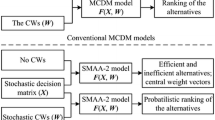Abstract
The problem of fitting a probability distribution, here log-Pearson Type III distribution, to extreme floods is considered from the point of view of two numerical and three non-numerical criteria. The six techniques of fitting considered include classical techniques (maximum likelihood, moments of logarithms of flows) and new methods such as mixed moments and the generalized method of moments developed by two of the co-authors. The latter method consists of fitting the distribution using moments of different order, in particular the SAM method (Sundry Averages Method) uses the moments of order 0 (geometric mean), 1 (arithmetic mean), −1 (harmonic mean) and leads to a smaller variance of the parameters. The criteria used to select the method of parameter estimation are:
-
- the two statistical criteria of mean square error and bias;
-
- the two computational criteria of program availability and ease of use;
-
- the user-related criterion of acceptability.
These criteria are transformed into value functions or fuzzy set membership functions and then three Multiple Criteria Decision Modelling (MCDM) techniques, namely, composite programming, ELECTRE, and MCQA, are applied to rank the estimation techniques.
Similar content being viewed by others
References
Ang, A.; Tang, W.H. 1984: Probability concepts in engineering planning and design: Vol. II, decision, risk and reliability. John Wiley and Sons, Inc., New York
Ashkar, F.; Bobée, B. 1987: The generalized method of moments as applied to problems of flood frequency analysis: Some practical results for the log-Pearson type 3 distribution. Journal of Hydrology 90, 199–217
Benayoun, R.; Roy, B.; Sussman, B. 1966: ELECTRE: une méthode pour guider le choix en présence de points de vue multiples. SEMA (Metra Intermational), Direction scientifique, Note de travail 49 Paris
Benson, M.A. 1968: Uniform flood-frequency estimating methods for federal agencies. Water Resources Research 4 (5), 891–908
Bobée, B. 1975: The log-Pearson Type 3 distribution and its application in hydrology. Water Resources Research 11 (5), 681–689
Bobée, B. 1976: Contributions à l'étude des débits maxima annuels de crue: représentation par les distributions statistiques. Ph.D. Thesis. Université Paul Sabatier, Toulouse
Bobée, B.; Robitaille, R. 1977: The use of the Pearson type 3 and log-Pearson type 3 distributions revisited. Water Resources Research 13 (2), 427–443
Bobée, B.; Ashkar, F. 1988: Sundry averages method for estimating parameters of the log-Pearson type 3 distribution. INRS-Eau, Scientific Report 251
Bobée, B.; Ashkar, F. 1991: The gamma family and derived distributions applied in hydrology. In: Yevjevitch, (ed.) Water Resources Publications, in press
Bogardi, J.; Duckstein, L.; Rumanbo, O. 1988: Practical generation of synthetic rainfall event time series in a semiarid climatic zone. Journal of Hydrology 103, 357–373
Cohon, J.L. 1978: Multiobjective programming and planning. Academic Press, New York
Condie, R. 1977: The log-Pearson type 3 distribution: TheT year event and its asymptotic standard error by maximum likelihood theory. Water Resources Research 13 (6), 987–991
Duckstein, L.; Opricovic, S. 1980: Multiobjective optimization in river basin development. Water Resources Research 16 (1), 14–20
Duckstein, L.; Bogardi, I.; Bardossy, A. 1990: Fuzzy sets in engineering: A tutorial. Proceedings, ASCE Specialty Conference of the WRPM Division, Fort-Worth, April, 434–441
Gershon, M.; Duckstein, L.; McAniff, R. 1982: Multiobjective river basin planning with qualitative criteria. Water Resources Research 18 (2), 193–202
Goicoechea, A.; Hansen, D.R.; Duckstein, L. 1982: Multiobjective decision analysis with engineering and business applications. John Wiley and Sons, Inc., New York
Gupta, V.K.; Duckstein, L. 1975: A stochastic analysis of extreme droughts. Water Resources Research 11 (2), 221–228
Hiessl, H.; Duckstein, L.; Plate, E. 1985: Multiobjective Q-analysis with concordance and discordance concepts. Applied Mathematics and Computation 17, 107–122
Nozdryn-Plotnicki, M.J.; Watt, W.E. 1979: Assessment of fitting techniques for the log-Pearson type 3 distribution using Monte Carlo simulation. Water Resources Research 15 (3), 714–718
Rao, D.V. 1980: Log-Pearson type 3 distribution: Method of mixed moments. ASCE, Journal of hydraulics Division 106 (6), 999–1019
Roy, B. 1971: Problems and methods with multiple objective functions. Mathematical Programming 1 (2), 239–266
Szidarovszky, F.; Gershon, M.E.; Duckstein, L. 1986: Techniques for multiobjective decision making in systems management. Elsevier Publications, Amsterdam
Tecle, A.; Fogel, M.; Duckstein, L. 1988: Multicriterion selection of wastewater management alternatives. ASCE Journal of Water Resources, Planning and Management 114 (4), 383–398
Tecle, A. 1988: Choice of multicriterion decision making technique for watershed management. Unpublished Ph.D. Dissertation, The University of Arizona, Tucson
W.R.C. 1981: Guidelines for determining flood flow frequency. U.S. Water Resources Council Hydrology Committee. Washington, D.C. Revised version 17B
Wymore, M.; Duckstein, L. 1989: Prioritizing of factory automation investments with multicriterion Q-Analysis. Proceedings. International Conference on MCDM in Industry and Service pp. 351–361, Bangkok, December
Zadeh, L.A. 1973: Outline of a new approach to the analysis of complex systems and decision processes. IEEE Trans. SMC 3, 28–44
Zeleny, M. 1973: Compromise programming. In: Cochrane, L.; Zeleny, M. (eds.), Multiple criteria decision making, pp. 263–301. University of South Carolina Press, Columbia
Zeleny, M. 1982: Multiple criteria decision making. McGraw-Hill, New York
Author information
Authors and Affiliations
Rights and permissions
About this article
Cite this article
Duckstein, L., Bobée, B. & Ashkar, F. A Multiple Criteria Decision Modelling approach to selection of estimation techniques for fitting extreme floods. Stochastic Hydrol Hydraul 5, 227–238 (1991). https://doi.org/10.1007/BF01544059
Accepted:
Issue Date:
DOI: https://doi.org/10.1007/BF01544059




